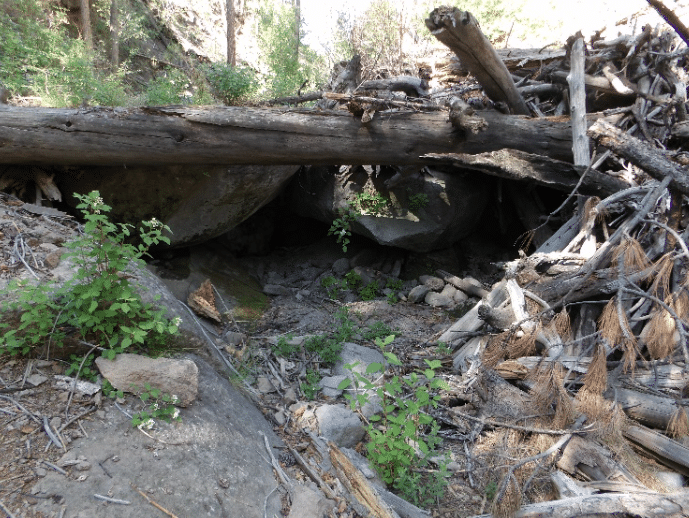 The combination of fallen tree, log pile and boulder directs water from flash floods to create a cave. Photo by Robert Dryja
The combination of fallen tree, log pile and boulder directs water from flash floods to create a cave. Photo by Robert Dryja
By ROBERT DRYJA
Los Alamos
We previously had reviewed how flash floods along Upper Pueblo Canyon affected its geologic and ecologic features. Increased erosion occurred as a result of the Cerro Grande fire. Piles of large branches and trunks occur along the canyon stream bed as a result of becoming stuck on protruding boulders as part of flash floods.
The power of flash floods is reflected in the scooping out of caves. Picture 1 shows a tree trunk that has fallen across the stream bed. It is four feet above the stream bed and water flows below it. A pile of logs on one side causes the water to flow to the other side below the tree trunk. Silt and smaller rocks have been washed away from under a large boulder to create a cave.
A type of ash called volcanic tuff erupted from the Valles Caldera. It is a relatively soft rock. It set the stage for the landscape seen today. Picture 2 shows a large, almost round boulder. It may be seen on the upper slopes adjacent to the canyon. Was it originally a denser ball of tuff in the volcano that was thrown out along with softer tuff around it? The boulder is four feet tall. Was the surrounding land also four feet deeper at one time but now has eroded away, exposing the boulder?
Picture 3 shows that some smaller rocks are similar to the large boulder. The sides of these rocks are curved and smooth. However, their overall shape is like a fat pancake rather than a round ball. A single rock may have been created originally from layers of ash falling on top of one another. The thin space between layers provided a flat pathway for separate rocks to eventually erode out shaped like a pancake.
Picture 4 shows that some of the rock formations look distinctly sedimentary. They are composed of multiple thin layers that fit together. Are these also the result of multiple layers of volcanic tuff falling on top of one another, similar to the pancake shaped boulders? Another possibility is based on the way that a deep layer of hot tuff cooled. The top surface would have cooled sooner than deeper down. The cooler area then could have contracted and pulled away from the deeper hotter tuff, forming a separate layer of rock. This process could have repeated again and again as heat from deep within the tuff slowly moved to the surface.
 A boulder sits up a slope. It has not eroded to the same degree as the volcanic tuff around it. Photo by Robert Dryja
A boulder sits up a slope. It has not eroded to the same degree as the volcanic tuff around it. Photo by Robert Dryja
 These rocks in vertical stacks like thick pancakes may have been a single rock at one time. Photo by Robert Dryja
These rocks in vertical stacks like thick pancakes may have been a single rock at one time. Photo by Robert Dryja
 Volcanic tuff laying in sedimentary layers. Photo by Robert Dryja
Volcanic tuff laying in sedimentary layers. Photo by Robert Dryja

